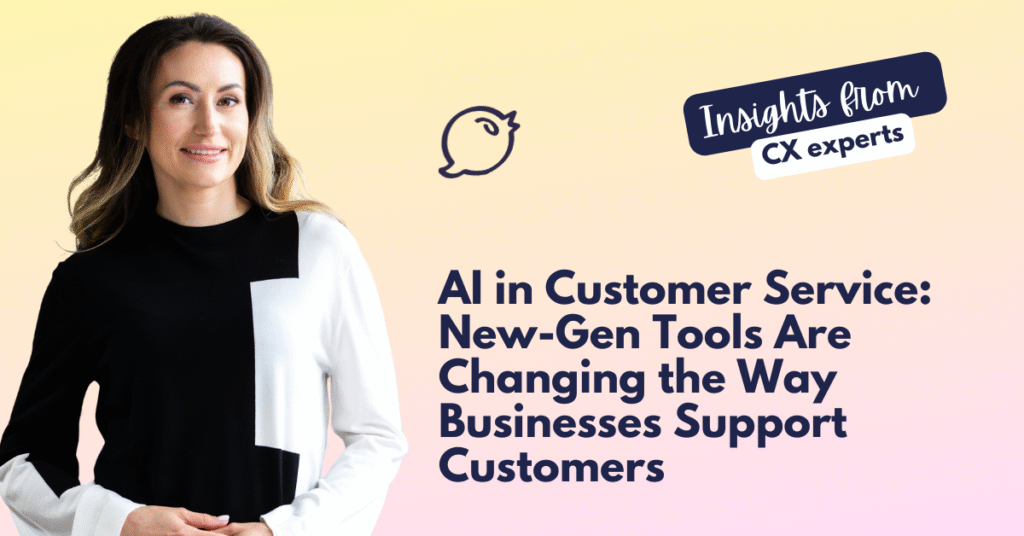AI in customer service: New-Gen tools are changing the way businesses support customers

Sandra Roosna
Askly CEO & Founder

Customer service used to mean frustrating chatbots, long wait times, repetitive questions, and support teams. Often struggling to keep up during busy hours, website technical issues or campaigns.
If you receive a quick reply that seems as if humans sent it, think once again. Probably not any more. Modern chatbots are extremely human-like.
Artificial intelligence (AI) is playing a big role in the shift that is already happening.
AI in customer service is about building smarter systems that support both customers and the people who help them.
At its best, AI feels less like a machine and more like an extra set of hands that never gets tired, remembers every detail, and helps your team focus on what actually matters.
What AI Can Do Well in Customer Support?
When people hear “AI in customer service,” they often think of chatbots that answer FAQs. That’s part of it, but the scope is much bigger now. AI can:
- Handle routine questions automatically (like tracking an order or resetting a password).
- Assist human agents by suggesting answers in real time.
- Spot patterns in customer messages, helping businesses identify issues before they spread.
- Translate languages instantly, making global support possible without extra staff.
Think of it like giving your team a digital co-pilot who can prepare the groundwork, so agents don’t spend hours repeating the same answers.
Why Businesses Are Turning to AI
1. Staying Available 24/7
Customers don’t work on your schedule. They reach out late at night, during weekends, or from different time zones. With AI chatbots, you can keep the lights on without burning out your team.
2. Faster and Cheaper Support
A lot of customer questions are repetitive. Automating those tasks not only reduces wait times but also saves businesses serious money. Some companies have reported cutting support costs nearly in half after introducing AI tools.
3. More Personalized Conversations
AI can analyze previous interactions and customer data to personalize responses. Instead of generic copy-paste answers, customers get suggestions that actually fit their needs. That builds trust and makes people more likely to stick with your brand.
4. Scaling Without the Stress
During seasonal peaks—holiday sales, product launches, or unexpected surges—AI makes it possible to handle more requests without hiring dozens of extra staff.
Examples of AI Tools in Action
- Chatbots & Virtual Assistants: Brands like ASOS use AI assistants to guide shoppers and recommend products. HSBC’s “Amy” answers routine banking questions, solving most of them without human involvement.
- Agent Assist Tech: Some platforms whisper suggestions into agents’ ears while they’re on calls, making them faster and more confident. Others summarize long customer emails into a few bullet points.
- Analytics & Insights: AI can flag frustrated customers based on their tone or word choice. That lets managers jump in before an issue escalates. It also highlights common problems that product teams should fix.
Getting Started Without Overcomplicating Things
A mistake many businesses make is trying to “do everything AI” at once. The smarter approach is to start small:
- Find your biggest pain point. Is it FAQs, order tracking, or multilingual requests? Start there.
- Test in one channel. Roll out AI on live chat or email first, not across every customer touchpoint.
- Measure results. Look at resolution times, customer feedback, and cost savings.
- Expand slowly. Once you see wins, bring AI into more areas of your support.
The best AI projects grow step by step—not through an overnight overhaul.
The Human Side: Challenges to Watch Out For
- Losing the Human Touch: Customers still want empathy, especially in sensitive situations. AI should never block access to real people.
- Team Resistance: Support agents may worry that AI will replace them. It’s key to position AI as a helpful assistant, not a threat.
- Data Privacy: Handling customer data responsibly is critical. Any AI system should follow compliance rules (GDPR, etc.) and be transparent about how data is used.
When these challenges are managed, AI works best as part of a hybrid model: routine issues handled by machines, while complex or emotional matters go to human agents.
What’s Next for AI in Customer Service?
We’re still at the beginning of the journey. A few things are already on the horizon:
- Predictive Service: AI spotting problems before customers complain.
- Emotion Recognition: Detecting frustration or satisfaction in tone of voice or wording.
- Smarter Voice Assistants: Moving away from clunky phone menus toward natural conversations.
- Visual Support: Imagine holding up your phone camera and an AI agent guiding you through a setup step by step.
Final Thoughts
AI in customer service is no longer a futuristic idea—it’s here, and businesses are already seeing results. The key isn’t choosing between AI or humans, but finding the right balance where both complement each other.
For businesses using platforms like Askly AI, this balance becomes practical: chatbots handle the repetitive, data-driven work, while human agents step in where empathy and creativity are needed. The outcome is faster support, happier customers, and more efficient teams.
Customer expectations will only rise from here. Companies that embrace AI thoughtfully will be the ones leading the way in delivering customer experiences that feel both efficient and personal.
About the author

Sandra Roosna
Askly CEO & Founder
Sandra Roosna is the founder and CEO of Askly, a multilingual customer support platform for e-commerce. With a background in international business and experience from Y Combinator’s Startup School, she built Askly to help online stores improve customer communication across Europe.
Want more happy customers with a small team? Askly can easily help you achieve it.
Free trial. No obligations. Start growing you business tomorrow.
Recent posts
AI in customer service that finally works.
No costs. No obligations.
